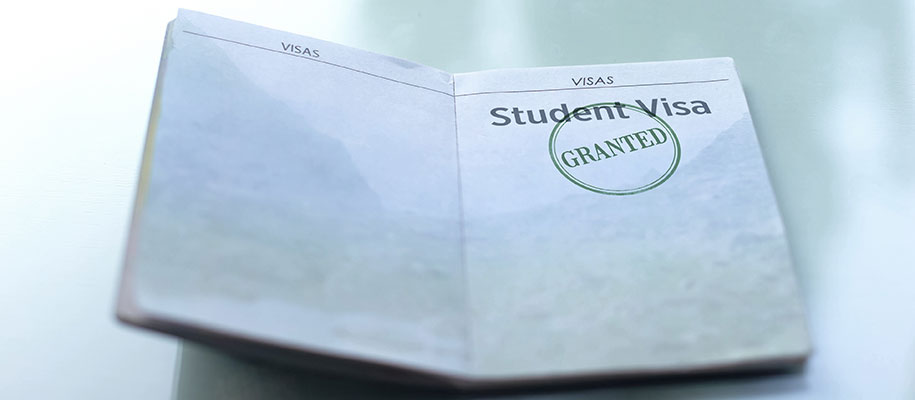You probably already know that you need a student visa to attend a US university, and it might seem like a mountain of paperwork stands between you and that little document. True, obtaining a student visa is not the easiest part of applying to university, but it’s well within your reach. The US government requires all international students studying in the United States to meet stringent eligibility requirements before and during their stay. Specific steps must be taken to secure each specific type of visa. These step-by-step instructions will help you better understand the necessary procedures to obtain your nonimmigrant (F-1) student visa.
What is a visa?
A visa is the proof of assessment conducted by the officials at the US embassy or consulate that certifies a person may seek admission to the United States for a specific purpose. Therefore, when you apply for a visa, you will need to submit certain documents to explain the purpose of your visit to the United States. The Student and Exchange Visitor Information System (SEVIS) is the Department of Homeland Security’s electronic database. It tracks and monitors nonimmigrant students and exchange visitors during their stay in the United States.
Nonimmigrant (F-I) student visa
A student visa is one of many categories of nonimmigrant visas. Nonimmigrants are visitors who stay in the United States temporarily for specified purposes within a limited amount of time. Your Certificate of Eligibility document (I-20 form) is necessary to obtain a nonimmigrant (F-1) student visa to attend school in the United States. This visa permits you to enter the United States to study at the institution or program you were accepted into.
Related: Everything You Need to Know About Student Visas
1. Gain admission to a university
The first step in the process is to be accepted at a full-time academic program at an institution authorized to enroll alien nonimmigrant students. Once admitted, you can start the necessary steps to apply for the I-20 document, and then for the actual F-1 visa itself. Both documents hinge on your full-time enrollment in an academic program. To apply for a student visa, the applicant must have a valid visa eligibility document (form I-20) issued by the university. To obtain a student visa, the applicant must submit their I-20 form, proof of SEVIS I-901 fee payment, a valid passport, financial documentation, and all of the required applications and documents for visa processing to a US embassy or consulate. Which brings us to our next step...
2. Consult with your US embassy or consulate
Student visa applicants should generally apply at the US embassy or consulate in their home countries. Check the website or call for specific visa application instructions, since each US embassy or consulate sets its own policies and procedures regarding visa processes. Students are encouraged to apply for their visa as soon as they receive the I-20 form to provide ample time for processing. US embassies or consulates can issue your F-1 entry visas up to 120 days in advance of your program start date in the United States. If you apply for your student visa more than 120 days before your start date as indicated on your I-20 form, the embassy or consulate will hold your application until they can consider your application for a student visa.
In most countries, student visa applicants must appear in person for an interview. However, each American embassy or consulate sets its own interview policies and procedures regarding student visas, so you should consult embassy websites or call for specific application instructions. For the current listings of US embassies and consulates abroad, visit the US Department of State. You'll find the latest information on visa processing, required materials, visa applications, and processing times as well.
3. Prepare the paperwork
In general, international students are required to present the following documents to the US embassy or consulate:
- Certificate of eligibility for nonimmigrant visa (I-20 form) issued by the college or university: Your assigned SEVIS ID number will be on the upper right corner of page one. Check to see that all information is correct, and sign the form on line #11. If you are under the age of 18, a parent or guardian also must sign. Please note: The spelling of your name and your date of birth must be exactly the same as what appears on your passport.
- A valid passport: Passport must be valid for at least six months after your proposed date of entry into the United States (unless country-specific agreements provide exemptions).
- Financial evidence that shows you have sufficient funds to cover your tuition and living expenses during the period you intend to study: At a minimum, you must prove you have sufficient funds for at least one year of study as reflected on the I-20 form. If you have more than one source of funding, please provide the required documentation corresponding to each source listed on the I-20 form (e.g., personal or family funds, official award, scholarship letter, etc.).
- Proof of the SEVIS I-901 fee payment: The SEVIS I-901 fee must be paid prior to the scheduled visa interview.
- Admission letter from the college or university
- Completed Nonimmigrant Visa Application form required by the US Department of State: Form DS-160, the Online Nonimmigrant Visa Application, takes about 90 minutes. Please note that after completing the DS-160, you need to print and keep the DS-160 barcode page, then visit the US embassy or consulate website where you will apply for additional country-specific instructions.
- One photograph: For the required photo format, please refer to the State Department website.
- Visa application fee: Check with the US embassy or consulate for the fee amount and how it must be paid, or visit the US Department of State. You will need to provide a receipt showing the visa application processing fee has been paid when you come for your visa interview.
Related: COVID–19's Impact on Student Visas and Scholarships
4. Collect additional forms and fees
All applicants should be prepared to provide additional information, such as transcripts or diplomas from previously attended institutions, TOEFL/SAT scores, or documents that demonstrate that the applicant intends to return home after his/her studies are completed, etc. New students (F-1) with an I-20 form are subject to a SEVIS fee for the maintenance of this electronic record. A SEVIS fee payment receipt must be included with most visa applications. Students should be prepared to present the SEVIS fee payment receipt at their US port of entry. Canadian citizens must pay the SEVIS fee before entering the United States. F-2 dependents are not required to pay the SEVIS fee. No assurances regarding the issuance of visas can be given in advance; therefore, final travel plans or the purchase of non-refundable tickets should not be made until a visa has been issued.
5. Receive approval
After the visa is granted and processed, check your passport to be sure you obtained an F-1 visa stamp. The name of your school and SEVIS ID number will be noted on your visa. You are required to enroll in that institution and no other upon your initial entry to the United States. Also, be certain the original I-20 form was returned to you, as you must have the original with you when you arrive in the United States. Sometimes, the document is returned to you in a sealed envelope, which must be presented to the immigration inspector when you arrive (in this case, do not open the envelope!).
6. Enter the United States
According to immigration regulations, F-1 student visa holders can seek admission to the United States up to 30 days prior to a program’s report date as shown on the I-20 form. During your flight to the United States, an airline attendant will distribute I-94 Arrival/Departure forms prior to landing. Since you have a student visa stamp in your passport, be sure to obtain a white I-94 form, not a green I-94W form. At the US port of entry, you will be required to present your passport, I-20 form, I-94 form, and customs form to a representative of the US Department of Homeland Security. The immigration officer will stamp your I-20 and I-94 forms upon entry. In most cases, the officer notes “D/S” (“Duration of Status”) on the stamp. This means that you are allowed to stay in the United States for the length of time indicated on your I-20 form, as long as you are maintaining full-time enrollment at the school that issued your I-20 form.
Related: How International Students Can Culturally Prepare to Study in the United States
In addition to all of the government resources listed here, be sure to also use any institutional resources that may be available for you during the visa application process. For example, the International Student and Scholar Institute (ISSI) at Northeastern University in Boston is an important resource for all incoming international students enrolling at the University. The ISSI assists all incoming international students in navigating the complexities of immigration regulations and procedures, and helps them achieve or maintain valid legal status. Be sure to do some research and check in with the international student services at your intended university for assistance.
Learn more about all the requirements to study in the United States—plus schools that are looking to enroll students like you!—with the articles and advice in our International Students section.







